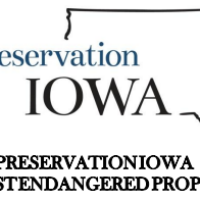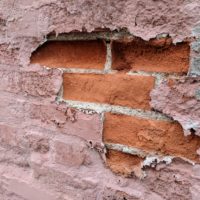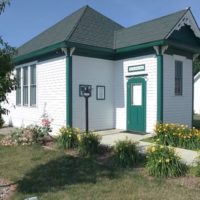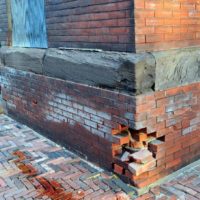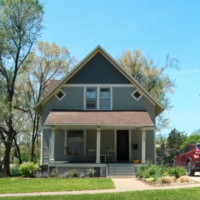Finding Your Preservation Story – Engaging Ideas
- Section 1: Preservation Curriculum for Teachers
- Section 2.1: Learning Objectives
- Section 2.2: Lesson Plans
- Section 3: 101 Ideas for Preservation Education
- Section 4.1: Archive Guide
- Section 4.2 – Glossary of Architecture Terms
- Section 4.3: Glossary of Preservation Terms
- Section 4.4: Research Guide
- Section 4.5: Letters to Parents and Admins
- Section 5.1: Print and Online Resources
- Section 5.2: People in Preservation
- Visit a local archive or history center by scheduling a class field trip. Ask librarians the best way to get started with research and ask them to share their favorite stories about preservation.
- Schedule a tour of a historic property. Ask the tour guide what stories about the property are recorded, but also ask her or him about stories that aren’t—unofficial ones that have been handed down or even hearsay.
- Spend a weekend afternoon in a local archive or special collections unit in your area researching an old property you’re interested in. Local historical societies, libraries, universities and colleges, and the State Historical Society of Iowa, all have excellent collections for you to consult, and of course, if you can’t travel to an archive, you can visit online collections and visit the archives virtually!
- Interview past residents of an old building you’re interested in and write down or record their stories.
- Write your home’s story. Who are the characters? What are their significant actions?
- Record the story you write about your home as an audiocast and consider posting it to a relevant online site or sharing it with Preservation Iowa.
- Rewrite your home’s story. Change a detail, a character, or a significant action and imagine how your home would be different today because of it.
- Write your home’s next chapter. Imagine what will happen to your home next, and plot out a series of likely—or unlikely—events that will change the course of its history.
- Write a series on your neighborhood. Start with the story you wrote for your first building or home and write others on properties located nearby. Do the stories overlap? Share with your neighbors or a neighborhood association, if you like.
- Turn your old building’s story into a play. Invite friends or family members to partake as actors or audience members.
- Film yourself telling your old building’s story. Show characters, stage plot action, and use props to make the story come to life. Consider sharing it with others via YouTube or other online forums in your community, or sharing it with Preservation Iowa.
- Draw a chronological timeline of your old building’s lifespan to visualize its history. What other major events in local, state, national, or international history occurred along the timeline you created? Add those to your building timeline to see how the history of your building fits into larger patterns of history.
- Create a time capsule of important documents and photographs of the home you currently live in. Seal and keep the capsule for future residents.
- Volunteer with a local preservation group to help restore an old property.
- Learn more about the residents of an old home by finding their names in U.S. Census Records and then looking up their names in local newspaper archives and online.
- Create a birth certificate for your old building. Include information like date of birth, initial characteristics, and original “parents” or owners.
- Study updates or additions to a new building. Why were they made?
- Ask a geologist about the land on which your home was built. Learn how the ground on which it was built and other nearby natural resources influenced its development.
- Compare your old building to another one nearby. How are they similar? If they are more different than similar, find out why.
- Play detective and search old police records or newspapers to see if any crimes were committed on or near the property you’re interested in.
- Piece together photographs of your old building—from oldest to most recent—to see how its exterior has changed through the years.
- Talk to a local historian about the cultural makeup of your community to see if it has influenced the architectural designs of your old building and others like it.
- Let the walls do the talking. See what they’re made of, if they’ve been covered with wallpaper or resurfaced, and imagine what stories they might tell if they could speak.
- Ask a local historian about what industries influenced the development of the town you live in. Share details with the historian about your home to see if these industries may have played a role in your building’s development or history.
- Discover old junk “treasures” by looking in attics, basements, crawl spaces, and other cavities inside the building or old barns and sheds on the property. What do your finds tell you about the building’s history?
- Locate the original owners of your old building. If they’re living, invite them over to see the building and learn more what it was like when they owned it.
- Pay an online visit the National Register of Historic Places (https://www.nps.gov/Nr/), maintained by the National Park Service, and search which nationally registered properties are closest to you.
- Ask a staff member at the State Historic Preservation Office (SHPO) if an old building you’re interested in qualifies for registration on the National Register of Historic Places. Go over the criteria for selection and the benefits of registering your place. If it is eligible for the National Register, make an action plan for registering your building.
- Trace your home’s architectural connection to other cultural movements by looking at both its age and its architectural features. Consider the artistic movements influencing culture at the time your home was built. Are there architectural features that suggest artistic movements going on at the same time, such as Modernism, the Arts & Crafts Movement, Baroque style, Bauhaus, or others? What are those features that remind you of the artistic movement you’ve identified?
- Bring your old building into the new digital age by using FourSquare or other social media locators to locate it. Update it frequently with photos and comments to begin creating its digital history.
- Compile a yearbook for your old building similar to the ones you’ve seen in specialty retail stores. Start by determining the “birth” year of your building and create a small book detailing local events and occurrences as well as state, national, or even international events to get a feel for the time when your building was constructed.
- Show friends and family members a picture of your old building and ask them what words come to mind. Record them and transfer them into a Wordle cloud or other form of word art to create a visual-textual representation of how your old building makes people feel.
- Research old buildings and homes your loved ones care about. Share what you find with them or consider presenting them with a story of that building as a surprise gift.
- Plan a scavenger hunt in an old building. Give participating teams a list of questions about architectural features for them to find answers to. The first team to finish wins elite preservationist status.
- Form a club at your school supporting preservation education efforts. Plan monthly meetings to discuss what sorts of preservation efforts are being done in the area or any preservation news, and together plan a school-wide social event to share preservation with the rest of your classmates.
- Research the history of your school building, its architectural features, and its impact on community history to share with students and teachers.
- Set up an information board in a busy hallway, where each month will feature an old building of interest, with plenty of fun facts, old photographs, and historical stories to build interest in preservation.
- Hold a fundraiser, anything as simple as a lemonade stand or chili cook-off to a full-blown 5k race, to raise funds for preservation efforts within your community. Let participants know where their donation dollars will go and provide them with plenty of interesting historical information related to well-known and well-preserved old buildings in your community.
- Contact a local news station or newspaper writer and tell her or him the story of the old building you’ve researched. Ask if that paper would be willing to run a short feature on that building, spotlighting its history and continued significance in the community.
- Notice which old building in your area might be lacking maintenance. Find the person responsible for that property and ask how you can help as a volunteer.
- If an elderly neighbor occupies an old home in your area and seems to be having trouble maintaining the property on his or her own, ask him or her if you can help—and while you’re helping, be sure to ask the owner for an account of the home’s history, too.
- Draw a cartoon strip telling part of your old building’s story; you might even use famous cartoon characters, such as Snoopy from the Peanuts Comics.
- Learn about the history of a building in your neighborhood or downtown that could be included on a walking tour. Work with your classmates to create a walking tour of several buildings and take another class or classes in your school on a walk through history.
- Create an interpretive presentation for a living history day at your school and tell the story of your building through the voice(s) of a former resident or residents.
- Visit the National Trust for Historic Preservation website to learn about the NTHP “This Place Matters” initiative (https://savingplaces.org/this-place-matters#.WGQ-JmQrIy4). Have each of your classmates take a picture with an historic place that matters to each of them and write a short argument to explain why this place matters. Have the class decide which place best represents the entire class, your community or your school, and arrange for the whole class to be photographed in front of that place. Submit your class photo to This Place Matters.
- Create a story map showing the various places on an historic farm and link the places to events on the farm or daily life at various points in history.
- Learn about the ways in which preservation can lead to sustainable, green living. Study the way windows were made historically. Learn about building construction techniques that led to older buildings having better energy conservation than newer ones. Find some examples of endangered historic buildings that might be torn down and do some math problems to calculate how much waste would go to the landfill if a building were demolished.
- Do a science experiment to learn about heat transfer from old windows vs new replacement windows.
- Do research in your local newspaper, online, or at the Secretary of Agriculture’s Office to find out about Century Farms in your area.
- Look up the location of your farm on old plat maps to see who owned your land throughout history.
- Find your old building’s “prequel” or what was the story of the land or previously standing properties before yours was built?
- Discover the people who moved through your property in addition to the ones who might have lived in it. Search Native American history collections as well as Military records to learn who might have been camping on the property while en route to another location.
- Learn if there is a country school near your home by visiting the Country Schools section of the Preservation Iowa website (http://www.preservationiowa.org/initiatives/country-schools/). Ask some senior citizens in your community what they remember about going to school in the old days.
- Survey your old building and identify potential future alterations. Discuss ideas for updates with staff at the State Historic Preservation Office (SHPO), and ask about the advantages and disadvantages that come with making those updates. How will rehabilitation projects improve the building and add to its story? How might some of the story be lost?
- Discover the history of railroads in your town. More than any other midwestern state, Iowa towns were shaped by railroad lines. How might nearby railroads have contributed to your old building’s story?
- Invite a local historian to come to your classroom. Ask him or her to share with the class his or her favorite stories about old buildings and the people who lived in them.
- Sing a building’s story. Choose a popular song on the radio and re-word it with lyrics that convey the meaning of the old building to the community.
- Sing an older song by using the lyrics created for a popular hit song and reworking them to fit with a song that was popular at the time your old building was built.
- Read Ain’t Nothing But a Man: My Quest to Find The Real John Henry, which features the author, Scott Reynolds Nelson, as a researcher rediscovering and rewriting the history of a man through his own narrative of search. How can you write a narrative about your search for rediscovering an old building?
- Research who resided in or used the historic building you’re interested in. If you find that one or more of those people are still living, locate them, and write a letter updating them on the current state of the building, share with them what you’ve learned, and ask them to share stories about their time in the building.
- Start a rehabilitation project on your own home. Ask your parents what needs to be updated; weigh the costs and the benefits of replacing materials with new, low-cost ones or higher-cost, more durable ones; and finally, partake in the work of rehabbing in order to understand decision-making processes involved in rehabilitation.
- Create and distribute posters or flyers that highlight the importance of an old building in your community. Include interesting facts, photos, and resources to build interest and support for that building’s continued preservation.
- Consult Sanborn Fire Insurance Maps online through the State Library of Iowa (http://www.statelibraryofiowa.org/services/online-resources/resources/sanborn-login) by getting a State Library Card number. Then, print out one of the maps for an area of your town and use different colored markers to identify old buildings in your town that were built around the same time. Do you see groupings form? What can this tell us about how your town was built? How it expanded?
- Arrange a walking tour or guided neighborhood talk of a historic area or district in your community. Work with local city government officials and preservationists to get started and spread the word about your tour.
- Construct an “ideal downtown neighborhood,” drawing out the style of buildings in this neighborhood and indicating the types or functions of those buildings. Discuss why this “ideal downtown neighborhood” doesn’t currently exist? Who (residents, property developers, or elected officials) might not want it? What geographical or architectural issues might be preventing its development?
- Check out images of different architectural styles listed in the guide. Decide which one is your favorite. Explore why this style is your favorite by writing out why. More than one favorite? Do several!
- Think about the difference between a “place” and a “building.” Have your class list out the similarities as well as the differences between the two.
- Choose your favorite old building in town and move it. Not literally of course, but if it were in a different location, how might you feel differently about it?
- Find an old building you care about that sits in a poor location. Construct an argument for its movement to a different one. How and why will the community benefit if it is moved?
- Build a case for saving an old building. Using the courts system as a guiding model, develop an opening statement, a case with witnesses, and a closing statement arguing for why an old building should be preserved.
- Develop an action plan for saving an old building. What sorts of human and material resources will your preservation initiative require? What will it cost? How will you articulate why those preservation costs are worthwhile?
- Build two models of an old building that has changed significantly over the years. The first model will be the original and the second will be the current model. Place them side by side for an interesting comparison or even snap a close-up shot of the models with the modern building as the backdrop.
- Brainstorm some useful technological advancements that would help preserve old buildings better. What are they? Search the internet to see if any scientists or developers have had similar thoughts and if they’re currently working on creating these advancements. Send in your suggestions if you think they would help.
- Play 20 questions. Think of an old building and then have a friend ask up to 20 questions that would help him or her identify the building you have in mind.
- Play back to the future. Create a list of characters from a past time (e.g., kings, paupers, and jesters) and write a comedy about them walking into an old building in your community. Would they be confused by the architecture? The style or function of the building? Would they be afraid or entertained?
- Act out a talk show or reality show in which you’re the host and your guests are a city planner, a preservationist, an elected official, and a community member, all of whom have a different interest in mind for an old building. How would they talk about their issues? How can you help them achieve a resolution?
- Guess the age of an old building pictured in photographs by looking at the styles of clothing worn by people in those photos. Using online references, guess the time period, class, and even career of those individuals.
- Draw the first architectural features you notice on an old building. Now compare those to shapes and objects found in nature. For a side-by-side comparison, draw those natural objects, too, to see how closely they align and how an architect may have used the natural object for inspiration and altered it for the building.
- Play I-spy. Compare two pictures of an old building and try to spot at least ten differences between an older photo and a newer one.
- Write a haiku for an old house. What can you say about an old building with so much history in so few words?
- Use your creative side to make a board game that tells the story of the process of saving an old building. What will the winner get? What incentives might players pick up along the way? What pitfalls to the preservation process might set a player back?
- Uncover the food chain—or building chain. Create a graphic organizer of the most important buildings in your community. Which ones are toward the top of the food chain, i.e., are given high-priority status and well maintained? Which ones are at the bottom, i.e., dilapidated or in desperate need of rehabilitation. What does this say about the values your community holds?
- Pick up a brochure or leaflet on an old building in your community. Analyze the brochure’s or leaflet’s effectiveness. In other words, what might you change about the language and the visuals used? How would you improve it?
- Look at the real estate advertisements in your local newspaper. How much do the older buildings cost in comparison to the newer ones? What conclusions can you draw about how well-preserved the older homes are based on how the homes are advertised?
- Think about the buildings we have today that would have been unthinkable or unnecessary 100 years ago. Likewise, discuss what buildings existed 100 years ago that we no longer have today. List out your guesses as to why.
- List the all the rooms in your current home and their functions. List all the rooms in an older home and their functions. Do you see any differences?
- Attend a city council meeting or a preservation commission meeting in your town and come prepared with questions to ask.
- Design a series of postcards that showcase a historic property. What visual design elements, shapes, coloring, etc., will you use to generate appeal to visitors?
- Arrange a “virtual field trip” if you or your classmates can’t travel to a historic property for a tour. Ask a preservationist or tour guide to video conference with your class, taking you through the historic property, if possible, and answering questions just as he or she might if you were taking the tour in person.
- Choose a building that used to serve one function—such as, for religious worship, school, commercial use, and so on—and now serves another. For example, in Ames, IA, the former Roosevelt Elementary School is now an upscale condominium building called The Roosevelt. How does a change in function affect the way community members experience the place you have chosen?
- Ask a gardener about the landscape and horticulture surrounding an old property. Does the gardener have an idea of what types of plants used to grow on this property? What plants does he or she maintain now and why?
- Write a will. Pretend that you own an old property or several old properties and write the will that delegates to whom ownership of these properties will transfer? Friends, family, local organizations or the city? Justify why you’ve decided to leave these places in the care of these people and groups.
- Foster pride in your community by developing a historic house tour that features a variety of architectural styles, such as, Queen Anne, Tudor, Spanish Revival, and so on.
- Build a sense of ownership and investment in old public properties by asking community members, “What buildings make you proud of our historic district?” Ask local government officials for permission to set up a large poster or chalk board on which community members strolling through the historic district can write their answers.
- Apply your mathematical skills by choosing three similar buildings and measuring their height, width, and length, and then creating a comparison chart.
- Discover the furry or feathered friends that used to live on or nearby a historic property. Look to old property ledgers to see if you can find out what animals a family or business owned and raised at that residence. Do any of the building’s features or other, smaller structures on the property indicate that these animals used to live there, too?
- Raise funds for a preservation project at your school. Ask a teacher for help to get started selling small goods and let supporters know where their funds will go.
- Search the archives for old audio or video media pertaining to a historic property you’re interested in. If the sound quality is poor, collaborate with an archivist to see if there’s any way to “rehab” or improve the quality with new technologies so that future researchers might benefit.
- Look at the exterior of an old building to determine its geometry and symmetry. See how many geometric shapes you can spot in the ornamentation. Study the symmetry by paying attention to which parts of the building were designed symmetrically and which were not. Are any asymmetrical features additions?
- Create a crossword of preservation terms you consider important. Ask a friend to solve your crossword and talk about the clues you give for each term and what they mean.
- Tell your building’s story to the members of Preservation Iowa. Send us an email or a letter with the story you found and we’ll save it to share with others. We’re excited to learn about your stories and we hope to share them with many others interested in Iowa’s history! Visit our website at http://www.preservationiowa.org for contact information.

